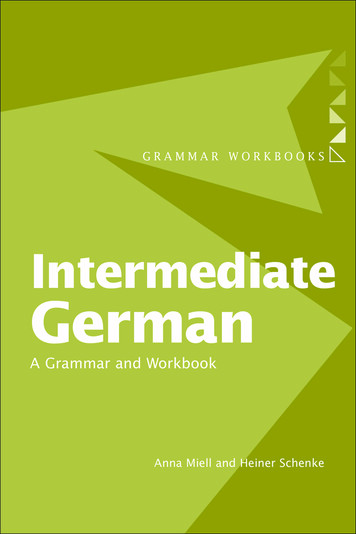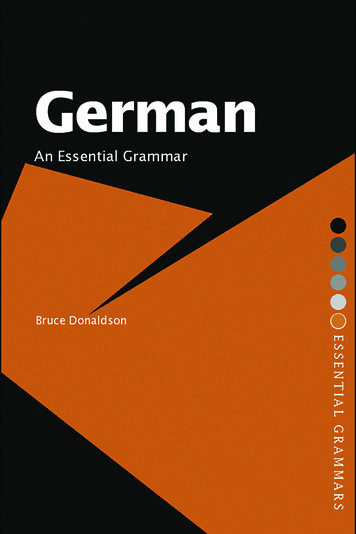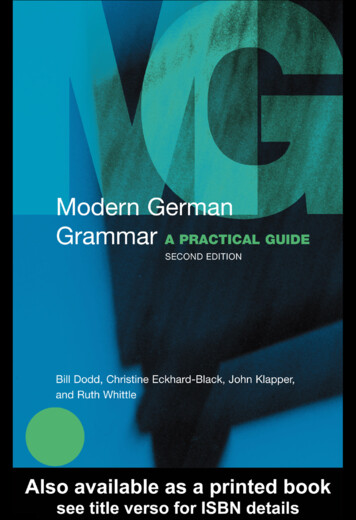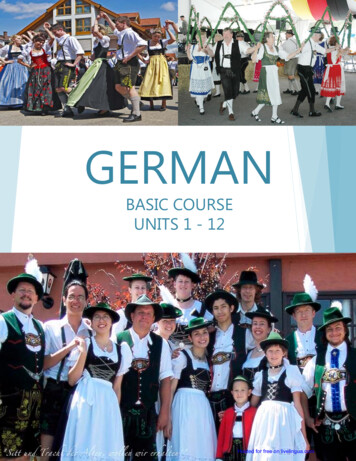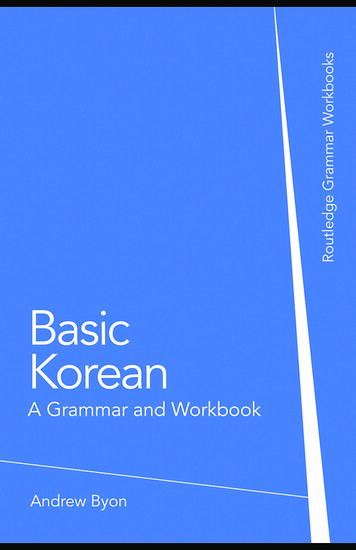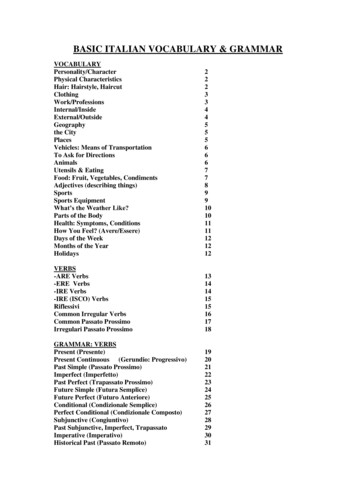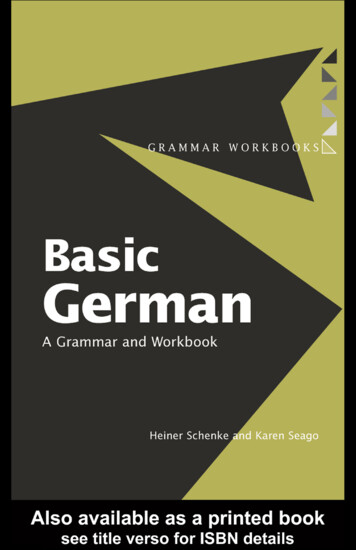
Transcription
BASIC GERMAN:A GRAMMAR AND WORKBOOKBasic German: A Grammar and Workbook comprises an accessiblereference grammar and related exercises in a single volume.It introduces German people and culture through the medium of thelanguage used today, covering the core material which students wouldexpect to encounter in their first years of learning German.Each of the 28 units presents one or more related grammar topics,illustrated by examples which serve as models for the exercises thatfollow. These wide-ranging and varied exercises enable the student tomaster each grammar point thoroughly.Basic German is suitable for independent study and for class use.Features include: Clear grammatical explanations with examples in both English andGerman Authentic language samples from a range of media Checklists at the end of each Unit to reinforce key points Cross-referencing to other grammar chapters Full exercise answer key Glossary of grammatical termsBasic German is the ideal reference and practice book for beginners butalso for students with some knowledge of the language.Heiner Schenke is Senior Lecturer in German at the University ofWestminster and Karen Seago is Course Leader for Applied Translationat the London Metropolitan University.
Other titles available in the Grammar Workbooks series are:Basic CantoneseIntermediate CantoneseBasic ChineseIntermediate ChineseIntermediate GermanBasic PolishIntermediate PolishBasic RussianIntermediate RussianBasic WelshIntermediate WelshTitles of related interest published by Routledge:Colloquial Germanby Dietlinde Hatherall and Glyn HatherallModern German Grammar: A Practical Guide, Second Editionby Bill Dodd, Christine Eckhard-Black, John Klapper, Ruth WhittleModern German Grammar Workbook, Second Editionby Heidi Zojer, Bill Dodd, Christine Eckhard-Black, John Klapper,Ruth Whittle
BASIC GERMAN:A GRAMMAR ANDWORKBOOKHeiner Schenke and Karen Seago
First published 2004by Routledge11 New Fetter Lane, London EC4P 4EESimultaneously published in the USA and Canadaby Routledge29 West 35th Street, New York, NY 10001Routledge is an imprint of the Taylor & Francis GroupThis edition published in the Taylor & Francis e-Library, 2005.“To purchase your own copy of this or any of Taylor & Francis or Routledge’scollection of thousands of eBooks please go to www.eBookstore.tandf.co.uk.” 2004 Heiner Schenke and Karen SeagoAll rights reserved. No part of this book may be reprintedor reproduced or utilised in any form or by any electronic, mechanical,or other means, now known or hereafter invented, includingphotocopying and recording, or in any information storage orretrieval system, without permission in writing from the publishers.British Library Cataloguing in Publication DataA catalogue record for this book is available from the British LibraryLibrary of Congress Cataloging in Publication DataA catalogue record for this book has been requestedISBN 0-203-64270-8 Master e-book ISBNISBN 0-203-67466-9 (Adobe eReader Format)ISBN 0–415–28404–X (hbk)0–415–28405–8 (pbk)
CONTENTSPrefacevii1 What’s different in German? Basic tips and patterns12 Verbs in the present tense63 Verb variations and irregular verbs124 Irregular verbs: haben and sein195 Separable verbs in the present tense246 Imperatives307 Questions368 Nouns and gender429 Plural of nouns5010 The four cases5611 The nominative case6212 The accusative case6513 The dative case7014 The genitive case7515 Personal pronouns7916 Possessive adjectives8717 Reflexive verbs9218 Negatives9719 Comparison of adjectives and adverbs10220 Modal verbs109
viContents21 The present perfect tense11622 The simple past tense12423 The future tense13024 Prepositions13525 Adjective endings14326 Numbers and dates15127 Conjunctions and clauses15828 Word order167Key to exercises and checklists175Glossary of grammatical terms200Common irregular verbs203Index205
PREFACEBasic German is aimed at absolute beginners and those learners who havesome knowledge of German but who need to refresh and consolidate basicstructures. It can be used on its own or in connection with any major Germancoursebook and it is suitable for self-study, class-based learning or referencepurposes.Presentation of grammarThe book explains the essentials of German grammar in clear and simplelanguage. The format is easily accessible and grammar topics follow a progression, which moves from simple aspects to more complex features. Formore in-depth study, there are cross-references to related grammar items.Explanations are simple and avoid specialised terminology while introducingkey terms. The vocabulary is practical and functional. It is introduced on acumulative basis and builds on vocabulary associated with topics featured inmajor course books.Structure of unitsThere are 28 units. Each unit covers one key grammar topic, which is contrasted with English structures where appropriate. Each topic starts out withan overview. This is followed by detailed explanation in an easy-to-followstep-by-step layout, breaking down complex aspects into simple segments.Examples in English and German illustrate each point and introduce relevantvocabulary.Checklists and exercisesIntegrated exercises allow immediate practice to consolidate each grammarpoint. Exercises are varied and progress from simple recognition to morecomplex application of grammar points.
viiiPrefaceA checklist at the end of each unit reinforces main points and provides anopportunity to self-assess understanding of the material covered.Answers to all exercises and checklists are at the end of the book.Using the book as a grammar referenceUnit headings indicate which grammar point is covered, and the glossaryprovides clear definitions and simple explanations of key grammatical terms.When appropriate, cross-references are provided within units.Extra featuresUnit 1 highlights some basic principles where the structures of German arefundamentally different from English. It explains their characteristics insimple terms and draws attention to underlying patterns. Extra tips on howto learn a language and learning specific grammar points are provided in thisunit and throughout the book.The book is suitable for independent learners GCSE preparation AS/A-level revision beginners’ courses at university and in further education adult education courses.
UNIT ONEWhat’s different in German? Basic tipsand patternsLearning German is often perceived as difficult. In 1880, Mark Twainfamously dubbed it ‘the awful German language’, protesting ‘Surely there isnot another language that is so slipshod and systemless, and so slippery andelusive to the grasp’ (Mark Twain, ‘The awful German language’, The TrampAbroad, 1880 (Harmondsworth: Penguin 1997), pp. 390–402).But is this really the case? One thing that is very helpful in learning Germanis that it is a systematic language, which follows rules. There are many ways tomake these rules easier to learn, and there are quite a few tips which will helpyou in learning the language.If you approach the language step by step you will find that it is mucheasier than you may think at the beginning. Here are pointers to some basicprinciples where German is different from English, and which may be usefulbefore you start out with the grammar proper.Spelling – capital letters and different charactersThere are a few ways in which German spelling is different from English.Capital letters for nounsGerman is one of the few languages which uses capital letters not only atthe beginning of sentences but also within sentences. In English, this appliesonly to proper names, to the personal pronoun ‘I’ and to personifications,such as ‘Love’.In German, all nouns must always be written with a capital letter, regardless of whether they are at the beginning of a sentence or in the middle:Der Mann und die Frau arbeiten jeden Tag am Computer.The man and the woman work at their computer every day.Note that the pronoun ich (‘I’) has no initial capital in German, but Sie(formal form of ‘you’) has.
2Unit 1Different charactersThe German alphabet has some characters which do not exist in the Englishalphabet:ß – the sharp ‘s’The letter ß, called eszett in German, is pronounced like the normal English‘s’, for example in ‘sun’ or ‘basic’.German uses this letter for instance after ei and ie, and after a, o, u if theyare pronounced long:heißenStraßegroßto be calledstreetbigThe umlauts – ä, ö, üThese are very important. They change the pronunciation of a word and,more importantly, its meaning:Mutter means ‘mother’, but Mütter is the plural form and means‘mothers’. Musste means had to, but müsste means ‘should’ or ‘ought to’.Three gendersAll nouns in German are masculine, feminine or neuter. This shows in theirsingular article: der for masculine, die for feminine, das for neuter.It is important to realise that gender in German is grammatical, notbiological as it is in English. This means that objects, concepts etc. which areneuter (‘it’) in English can be masculine, feminine or neuter in German:der Tischdie Türdas Fensterthe table (masculine)the door ( feminine)the window (neuter)Whenever you learn a new noun, always learn it with its gender: the best wayto do it is to learn it with its article. You will find that this will pay off in thelong term.EndingsOne of the principal differences between English and German is that inGerman words take specific endings depending on their relationship to other
Unit 13parts of the sentence. This applies to verbs, articles and possessive adjectivesand adjectives.VerbsThese are words describing the ‘action’ of a sentence, such as ‘to run’, ‘tothink’. For example, the German verb ‘to go’ has different endings when usedwith ‘I’, ‘he’ and ‘they’:Ich gehe.Er geht.Sie gehen.I go.He goes.They go.Articles and possessive adjectivesThese are words linked to a noun such as ‘a’, ‘the’, ‘my’ or ‘his’. For example,the indefinite article meaning ‘a’ changes in German when it is linked tothe subject of the sentence (ein Mann) or the object of the sentence (einenMann):Ist das ein Mann?Da drüben sehe ich einen Mann.Is that a man?I can see a man over there.AdjectivesThese words, which describe the quality of a noun, such as a ‘new’ computer,an ‘intelligent’ woman, a ‘beautiful’ house, follow a similar pattern when theyappear in front of a noun. In German adjectives can have different endingswhen they are linked to a masculine noun (ein neuer Computer), a femininenoun (eine intelligente Frau) or a neuter noun (ein schönes Haus).CasesOne of the most important features of German is that you can tell whatfunction a noun performs in a sentence by its ending and the form of thearticle. These show its case. For example, a noun can be the subject of thesentence, i.e. the ‘agent’ of what is happening:Der Hund beißt den Mann.The dog bites the man.Or it can be the object, i.e. the ‘receiver’ of the action in the sentence:Der Hund beißt den Mann.The dog bites the man.
4Unit 1The subject and the object are in different cases, which means that the article(‘the’) has a different ending. Both ‘dog’ and ‘man’ are masculine (der) but‘the dog’ is the subject (der Hund) and the man is the object (den Mann).Word orderWord order is much more flexible in German than in English, but there aresome very important rules. The most important apply to the position of thefinite verb. Here are some basic principles, which illustrate the difference toEnglish word order. The finite verb is the second idea in most statements:Er hat zwei Brüder.Morgen fahre ich nachManchester. The finite verb goes at the beginning of a sentence in orders and manyquestions:Öffnet das Fenster!Hast Du morgen Zeit? He has two brothers.Tomorrow I’m going to Manchester.Open the window, please.Are you free tomorrow?The finite verb goes at the end in subordinate clauses:Ich kann morgen nicht kommen, weil ich nach Manchester fahre.I can’t come tomorrow because I’m going to Manchester. If there are two verb forms, one of them goes at the end:Morgen muss ich nach Manchester fahren.Tomorrow I have to go to Manchester.TensesEnglish tenses differentiate between an action happening at the moment(‘I am working’) and an action taking place regularly (‘I work at Harrods’).In German, this difference does not exist. The finite verb form is the same inboth statements:Ich arbeite.Ich arbeite bei Harrods.I am working.I work at Harrods.The past in English is expressed either by the present perfect tense (whensomething happened recently or has a connection to the present: ‘I was
Unit 15working’ or the simple past tense (when something happened at a certaintime in the past or has no link to the present: ‘I worked’). German is simpler:you normally use the present perfect when you talk about the past regardless of when it happened, and you normally use the simple past in writtenGerman.And finally – looking for principlesGerman is a very systematic language, and very soon you will realise thatthere are certain patterns which occur again and again. If you bear this inmind you will see that, after the first few weeks of a fairly steep learningcurve, things will become easier and you will recognise these patterns.Buy a good dictionary. It not only gives you a list of translations butalso tells you how to pronounce unfamiliar words and gives you importantgrammatical information, for example whether a verb takes a certain case orwhat the plural is for a noun. Throughout the book, we tell you how to workwith dictionaries to get this kind of information and how it is relevant.Checklist1 Where do you use capital letters in German?2 When do you use the letter ß?3 Why are umlauts important?4 What is the difference between the use of gender in Germanand English?5 Give an example where a word changes its ending inGerman.6 What is one of the most important principles affectingGerman word order?7 Is there a difference between ‘I am working’ and ‘I work’ inGerman?
UNIT TWOVerbs in the present tenseWhat is a verb?A verb usually describes what a perso
German is one of the few languages which uses capital letters not only at the beginning of sentences but also within sentences. In English, this applies only to proper names, to the personal pronoun ‘I’ and to personifications, such as ‘Love’. In German, all nouns must always be written with a capital letter, regard-less of whether they are at the beginning of a sentence or in the .
